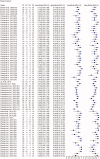Salivary biomarkers for cancer diagnosis: a meta-analysis
- PMID: 32056455
- PMCID: PMC7877992
- DOI: 10.1080/07853890.2020.1730431
Salivary biomarkers for cancer diagnosis: a meta-analysis
Abstract
Background: Saliva represents a promising non-invasive source of novel biomarkers for diagnosis and prognosis cancer. This meta-analysis evaluates the diagnostic value of salivary biomarkers for detection of malignant non-oral tumours to better define the value of saliva as an alternative liquid biopsy.Materials and methods: We performed a systematic review and meta-analysis. PubMed, Embase, LILACS and the Cochrane Library were searched to identify articles that examined the potential of salivary biomarkers for the diagnosis of malignant non-oral tumours. To assess the overall accuracy, we calculated the diagnostic odds ratio (DOR), area under hierarchical summary receiver operating characteristic (AUC) curve, sensitivity, specificity, positive likelihood ratio (PLR) and negative likelihood ratio (NLR) using a random- or fixed-effects model. Heterogeneity and publication bias were assessed. Statistical tests were two-sided.Results: One hundred fifty-five study units from 29 articles with 11,153 subjects were included. The pooled sensitivity, specificity, PLR, NLR, DOR and AUC were 0.76 (95% confidence intervals (CI), 0.74-0.77), 0.76 (95% CI, 0.75-0.77), 3.22 (95% CI, 2.92-3.55), 0.31 (95% CI, 0.28-0.34), 13.42 (95% CI, 12.28-15.96) and 0.85 (95% CI, 0.84-0.87), respectively.Conclusion: Salivary biomarkers may be potentially used for non-invasive diagnosis of malignant non-oral tumours.Key messagesThis meta-analysis evaluates the diagnostic value of salivary biomarkers for detection of malignant non-oral tumours to better define the role of saliva as an alternative liquid biopsy.Salivary biomarkers showed 85% accuracy for cancer distant to the oral cavity.Saliva represents a promising non-invasive source of novel biomarkers in cancer.
Keywords: Saliva; cancer; diagnosis; liquid biopsy; meta-analysis; salivaomics; salivary biomarkers.
Conflict of interest statement
R.L.-L. reported Nasasbiotech during the conduct of the study; received grants and personal fees from Roche and Merck, personal fees from AstraZeneca, Pharmamar, Leo and Bayer and personal fees and non-financial support from BMS outside the submitted work. The rest of the authors have nothing to disclose.
Figures








Comment in
-
Commentary on: Salivary biomarkers for cancer diagnosis: a meta-analysis.Ann Med. 2020 May-Jun;52(3-4):145. doi: 10.1080/07853890.2020.1743351. Epub 2020 Mar 22. Ann Med. 2020. PMID: 32167392 Free PMC article. No abstract available.
-
Response to commentary by Lu and Wang on "Salivary biomarkers for cancer diagnosis: a meta-analysis".Ann Med. 2020 May-Jun;52(3-4):146. doi: 10.1080/07853890.2020.1746391. Epub 2020 Apr 2. Ann Med. 2020. PMID: 32202950 Free PMC article. No abstract available.
Similar articles
-
The Potential Use of Salivary miRNAs as Promising Biomarkers for Detection of Cancer: A Meta-Analysis.PLoS One. 2016 Nov 10;11(11):e0166303. doi: 10.1371/journal.pone.0166303. eCollection 2016. PLoS One. 2016. PMID: 27832115 Free PMC article.
-
Salivary DNA Methylation as an Epigenetic Biomarker for Head and Neck Cancer. Part I: A Diagnostic Accuracy Meta-Analysis.J Pers Med. 2021 Jun 17;11(6):568. doi: 10.3390/jpm11060568. J Pers Med. 2021. PMID: 34204396 Free PMC article. Review.
-
Identification of common salivary miRNA in oral lichen planus and oral squamous cell carcinoma: systematic review and meta-analysis.BMC Oral Health. 2024 Oct 4;24(1):1177. doi: 10.1186/s12903-024-04986-0. BMC Oral Health. 2024. PMID: 39367474 Free PMC article.
-
Pepsin in Saliva as a Diagnostic Marker for Gastroesophageal Reflux Disease: A Meta-Analysis.Med Sci Monit. 2018 Dec 31;24:9509-9516. doi: 10.12659/MSM.913978. Med Sci Monit. 2018. PMID: 30596632 Free PMC article.
-
Diagnostic Value of Salivary miRNA in Head and Neck Squamous Cell Cancer: Systematic Review and Meta-Analysis.Int J Mol Sci. 2021 Jun 29;22(13):7026. doi: 10.3390/ijms22137026. Int J Mol Sci. 2021. PMID: 34209954 Free PMC article.
Cited by
-
Salivary biomarkers in breast cancer diagnosis: A systematic review and diagnostic meta-analysis.Cancer Med. 2022 Jul;11(13):2644-2661. doi: 10.1002/cam4.4640. Epub 2022 Mar 22. Cancer Med. 2022. PMID: 35315584 Free PMC article.
-
Gastric Cancer and Microbiota: Exploring the Microbiome's Role in Carcinogenesis and Treatment Strategies.Life (Basel). 2025 Jun 23;15(7):999. doi: 10.3390/life15070999. Life (Basel). 2025. PMID: 40724502 Free PMC article. Review.
-
Exploring Salivary Biomarkers for Tumor Diagnosis: A Narrative Review.Cureus. 2024 Jul 30;16(7):e65725. doi: 10.7759/cureus.65725. eCollection 2024 Jul. Cureus. 2024. PMID: 39211674 Free PMC article. Review.
-
Diagnostic Accuracy of Salivary Biomarkers in Detecting Early Oral Squamous Cell Carcinoma: A Systematic Review and Meta-Analysis.Asian Pac J Cancer Prev. 2022 May 1;23(5):1483-1495. doi: 10.31557/APJCP.2022.23.5.1483. Asian Pac J Cancer Prev. 2022. PMID: 35633529 Free PMC article.
-
Correlation of Soluble CD44 Expression in Saliva and CD44 Protein in Oral Leukoplakia Tissues.Cancers (Basel). 2021 Nov 16;13(22):5739. doi: 10.3390/cancers13225739. Cancers (Basel). 2021. PMID: 34830890 Free PMC article.
References
-
- Schiffman JD, Fisher PG, Gibbs P. Early detection of cancer: past, present, and future. Am Soc Clin Oncol Educ Book. 2015:57–65. - PubMed
-
- Nair M, Sandhu SS, Sharma AK. Cancer molecular markers: a guide to cancer detection and management. Semin Cancer Biol. 2018;52:39–55. - PubMed
-
- Crowley E, Di Nicolantonio F, Loupakis F, et al. . Liquid biopsy: monitoring cancer-genetics in the blood. Nat Rev Clin Oncol. 2013;10:472–484. - PubMed
Publication types
MeSH terms
Substances
LinkOut - more resources
Full Text Sources
Other Literature Sources
Medical
